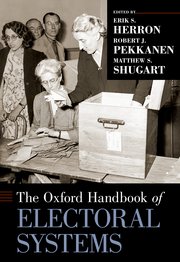My chapter in The Oxford Handbook of Electoral Systems
Edited by Erik S. Herron, Robert J. Pekkanen, and Matthew S. Shugart
 Italy stands out among advanced industrialized democracies because of its frequency of major electoral reforms. In the postwar period, Italy has experienced four major electoral systems: the proportional representation (PR) system of the First Republic (1948–1992), mixed-member majoritarian (MMM, 1993–2005), and two varieties of PR with majority bonus (2005–2015, 2015–2017), plus a MMM in 2017. In addition, there have been many failed attempts at electoral reform through legislation or referendum. The frequency of electoral reform makes Italy an important case for investigating the causes and effects of electoral system change. However, the path to each change has been somewhat idiosyncratic: the major reform of 1993 came against the backdrop of revelations of massive corruption, while the 2005 reform can be understood as an attempt to engineer divided government by an incumbent coalition expecting losses in the next election. The effects of the electoral reforms have also not always been as expected.
Italy stands out among advanced industrialized democracies because of its frequency of major electoral reforms. In the postwar period, Italy has experienced four major electoral systems: the proportional representation (PR) system of the First Republic (1948–1992), mixed-member majoritarian (MMM, 1993–2005), and two varieties of PR with majority bonus (2005–2015, 2015–2017), plus a MMM in 2017. In addition, there have been many failed attempts at electoral reform through legislation or referendum. The frequency of electoral reform makes Italy an important case for investigating the causes and effects of electoral system change. However, the path to each change has been somewhat idiosyncratic: the major reform of 1993 came against the backdrop of revelations of massive corruption, while the 2005 reform can be understood as an attempt to engineer divided government by an incumbent coalition expecting losses in the next election. The effects of the electoral reforms have also not always been as expected.
